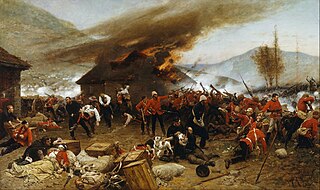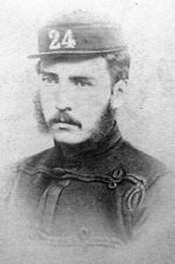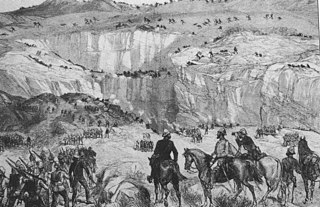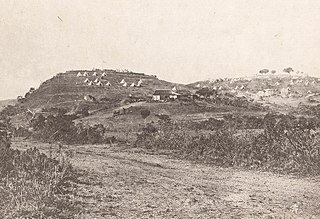
The Battle of Rorke's Drift, also known as the Defence of Rorke's Drift, was an engagement in the Anglo-Zulu War. The successful British defence of the mission station of Rorke's Drift, under the command of Lieutenants John Chard of the Royal Engineers and Gonville Bromhead, of the 24th Regiment of Foot began once a large contingent of Zulu warriors broke off from the main force during the final hour of the British defeat at the day-long Battle of Isandlwana on 22 January 1879, diverting 6 miles (9.7 km) to attack Rorke's Drift later that day and continuing into the following day.

The South Staffordshire Regiment was a line infantry regiment of the British Army in existence for only 68 years. The regiment was created in 1881 under the Childers Reforms by the amalgamation of the 38th Regiment of Foot and the 80th Regiment of Foot. The regiment saw service in the Second Boer War, World War I and World War II.

The Battle of Isandlwana on 22 January 1879 was the first major encounter in the Anglo-Zulu War between the British Empire and the Zulu Kingdom. Eleven days after the British invaded Zululand in Southern Africa, a Zulu force of some 20,000 warriors attacked a portion of the British main column consisting of approximately 1,800 British, colonial and native troops with approximately 350 civilians. The Zulus were equipped mainly with the traditional assegai iron spears and cow-hide shields, but also had a number of muskets and antiquated rifles.

Major Gonville Bromhead VC was a British Army officer and recipient of the Victoria Cross, the highest award for valour in the face of the enemy that can be awarded to members of the British armed forces. He received the medal for his part in the defence of Rorke's Drift in January 1879, in which a small British garrison of 139 soldiers successfully repulsed an assault by some 4,000 Zulu warriors. Bromhead was portrayed by Michael Caine in the film Zulu, which depicted the battle.
Anthony Clarke Booth was an English recipient of the Victoria Cross, the highest and most prestigious award for gallantry in the face of the enemy that can be awarded to British and Commonwealth forces.

Nevill Josiah Aylmer Coghill VC was a British Army officer and recipient of the Victoria Cross, the highest and most prestigious award for gallantry in the face of the enemy that can be awarded to British and Commonwealth forces.

The South Wales Borderers was a line infantry regiment of the British Army in existence for 280 years.

The Gloucestershire Regiment, commonly referred to as the Glosters, was a line infantry regiment of the British Army from 1881 until 1994. It traced its origins to Colonel Gibson's Regiment of Foot, which was raised in 1694 and later became the 28th Regiment of Foot. The regiment was formed by the merger of the 28th Regiment with the 61st Regiment of Foot. It inherited the unique distinction in the British Army of wearing a badge on the back of its headdress as well as the front, a tradition that originated with the 28th Regiment after it fought in two ranks back to back at the Battle of Alexandria in 1801. At its formation the regiment comprised two regular, two militia and two volunteer battalions, and saw its first action during the Second Boer War.

The Battle of Ulundi took place at the Zulu capital of Ulundi on 4 July 1879 and was the last major battle of the Anglo-Zulu War. The British army broke the military power of the Zulu nation by defeating the main Zulu army and immediately afterwards capturing and burning the royal kraal of oNdini.

The Battle of Intombe was an action fought on 12 March 1879, between Zulu troops loyal to Mbilini waMswati and British soldiers and African civilian conductors, drivers and voorloopers (scouts) defending a convoy of wagons on the road from Derby to Lüneberg. The convoy straggled badly along the road due to the rains and bogged on both sides of the Intombe river, which had risen and was in spate due to the rains. Most of the wagons were laagered, somewhat haphazardly, close to the river on the Derby side with a small party and two wagons on the Lüneberg side.

The Devonshire Regiment was a line infantry regiment of the British Army that served under various titles and served in many wars and conflicts from 1685 to 1958, such as the Second Boer War, the First World War and the Second World War. In 1958 the regiment was amalgamated with the Dorset Regiment to form the Devonshire and Dorset Regiment which, in 2007, was amalgamated with the Royal Gloucestershire, Berkshire and Wiltshire Regiment, the Royal Green Jackets and The Light Infantry to form a new large regiment, The Rifles.
The 91st Regiment of Foot was a Line Regiment of the British Army, raised in 1794. Under the Childers Reforms it amalgamated with the 93rd Regiment of Foot to form the Argyll and Sutherland Highlanders in 1881.

The 57th Regiment of Foot was a regiment of line infantry in the British Army, raised in 1755. Under the Childers Reforms it amalgamated with the 77th Regiment of Foot to form the Middlesex Regiment in 1881.

The Wiltshire Regiment was a line infantry regiment of the British Army, formed in 1881 under the Childers Reforms by the amalgamation of the 62nd (Wiltshire) Regiment of Foot and the 99th Duke of Edinburgh's (Lanarkshire) Regiment of Foot.
The 80th Regiment of Foot (Staffordshire Volunteers) was an infantry regiment of the British Army, raised in 1793. Under the Childers Reforms it amalgamated with the 38th (1st Staffordshire) Regiment of Foot to form the South Staffordshire Regiment in 1881.
The 83rd Regiment of Foot was a British Army line infantry regiment, which was formed in Ireland in 1793 for service in the French Revolutionary Wars. The regiment served in the West Indies, South Africa and the Peninsular War, and after the end of the wars with France spent much of the nineteenth century in colonial garrisons. Among other service, the 83rd fought in the Ceylon Great Rebellion of 1817–18, the Canadian Rebellions of 1837, and the Indian Rebellion of 1857. Under the Childers Reforms, the regiment amalgamated with the 86th Regiment of Foot to form the Royal Irish Rifles in 1881.

Major General Sir Harcourt Mortimer Bengough joined the British Army in 1855, and retired in 1899, after more than forty years of distinguished service from the Crimea to all quarters of the Empire.

The 12 January 1879 action at Sihayo's Kraal was an early skirmish in the Anglo-Zulu War. The day after launching an invasion of Zululand, the British Lieutenant-General Lord Chelmsford led a reconnaissance in force against the kraal of Zulu Chief Sihayo kaXongo. This was intended to secure his left flank for an advance on the Zulu capital at Ulundi and as retribution against Sihayo for the incursion of his sons into the neighbouring British Colony of Natal.

Lt Gen Richard Thomas Glyn was a British Army officer. He joined the 82nd Regiment of Foot by purchasing an ensign's commission in 1850. Glyn served with the regiment in the Crimean War and rose in rank to captain before transferring to the 24th Regiment of Foot in 1856. He served with that regiment in the Indian Mutiny and was appointed to command it in 1872. In 1875 he accompanied the 1st battalion of the regiment on service in the Cape Colony and fought with them in the 9th Cape Frontier War of 1877–78. He was appointed a Companion of the Order of the Bath after the war.

Fort Pearson was a fortification constructed by the British on the Natal side of the border with Zululand in the lead up to the 1879 Anglo-Zulu War. An earthen redoubt on a 300-foot (100 m) high cliff overlooking the Tugela River, the fort and its two external redoubts commanded an important river crossing. The crossing was used by one of the columns of the first invasion of January 1879, that was then besieged at Eshowe in Zululand. The crossing was used again by the Eshowe relief column in March and the second invasion in April. The fort was strengthened in April 1879 and connected to Pietermaritzburg by telegraph by June. The war was won by the British in July but the fort was briefly occupied again by British troops in 1883 during the Third Zulu Civil War.
















